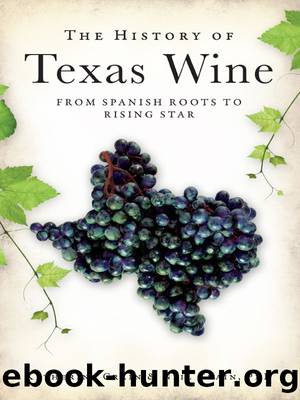The History of Texas Wine: From Spanish Roots to Rising Star by Katherine Crain Neil Crain PhD

Author:Katherine Crain, Neil Crain PhD [Katherine Crain, Neil Crain PhD]
Language: eng
Format: epub
Tags: Cooking, Beverages, Alcoholic, General, History, United States, State & Local, Southwest (AZ; NM; OK; TX)
ISBN: 9781625845627
Google: Ht12CQAAQBAJ
Publisher: Arcadia Publishing
Published: 2013-04-23T04:58:29+00:00
CHAPTER 9
Southeastern Wine Region of Texas
Like the other wine regions of Texas, the Southeastern Region is big, and the wineries are spread out. Visiting more than a few of the wineries in a single day is difficult. There are a few old-timers in the region, but many of the wineries are relatively new and do not yet produce enough grapes to bottle estate wines. Similar to the Northern Wine Region, there are a number of wineries that also serve as a bistro.
GEOGRAPHY AND AVAS
The Southeastern Wine Region of Texas is the second largest in Texas. The region is bound on the north by a line running east-southeast of Waco to the Louisiana border, on the west by the IH-35 corridor and on the south by the Gulf of Mexico. Even though the region is more than one quarter of the entire state, there are no designated AVAs in the region. Parts of the Southeastern Region get a lot of rain. The average annual rainfall along the coast is almost fifty inches. As you move south and west, the annual rainfall decreases to about twenty-eight inches per year around San Antonio and drops to a little more than seventeen inches near Laredo. Elevation of the Southeastern Region ranges from about 470 feet above sea level in Waco to about 30 feet near the coast.
Vintners in the region face serious challenges. The rainfall in parts of the region can cause several problems. Rainfall in July, near harvesting time, can dilute the juice in the grapes, making thin wine. Damp conditions favor the growth of root rot, powdery mildew and other fungal diseases. Another common problem in the region is Pierceâs disease. Pierceâs disease is often carried by the glassy-winged sharpshooter, an insect that favors the land around waterways. The abundance of streams, rivers, bayous and swamps in parts of the region provides the insect with easy access to grapevines, which it inoculates with the disease as it feeds. Phylloxera is also a common problem. Despite these challenges, there are at least twenty-three wineries in the Southeastern Region. Most of the wineries are concentrated in and around Bryan, Orange and Houston.
Download
This site does not store any files on its server. We only index and link to content provided by other sites. Please contact the content providers to delete copyright contents if any and email us, we'll remove relevant links or contents immediately.
Machine Learning at Scale with H2O by Gregory Keys | David Whiting(4261)
Never by Ken Follett(3885)
Fairy Tale by Stephen King(3308)
The Man Who Died Twice by Richard Osman(3041)
Reminders of Him: A Novel by Colleen Hoover(3012)
Will by Will Smith(2875)
Rationality by Steven Pinker(2330)
Can't Hurt Me: Master Your Mind and Defy the Odds - Clean Edition by David Goggins(2278)
It Starts With Us (It Ends with Us #2) by Colleen Hoover(2257)
Friends, Lovers, and the Big Terrible Thing by Matthew Perry(2184)
The Becoming by Nora Roberts(2156)
The Stranger in the Lifeboat by Mitch Albom(2094)
Love on the Brain by Ali Hazelwood(2028)
New Morning Mercies: A Daily Gospel Devotional by Paul David Tripp(1900)
HBR's 10 Must Reads 2022 by Harvard Business Review(1822)
A Short History of War by Jeremy Black(1818)
The Strength In Our Scars by Bianca Sparacino(1818)
Never Finished: Unshackle Your Mind and Win the War Within by David Goggins(1680)
A Game of Thrones (The Illustrated Edition) by George R. R. Martin(1671)
